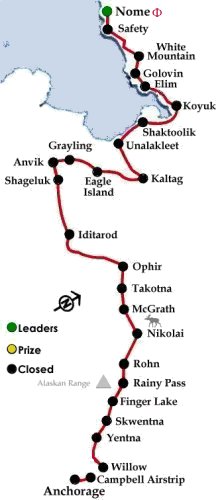Iditarod 2011 – Day 13
 Everyone is traveling West on the northern coast of the Norton Sound and the weather continues to be good.
Everyone is traveling West on the northern coast of the Norton Sound and the weather continues to be good.
While everyone talks about John Baker breaking the overall record for the race, few have noted that he smashed Doug Swingley’s 1995 record for the Southern Route: 9 days 2:42:19. Breaking John’s new record on the Northern Route is very possible, but the record on the Southern Route should stand for quite a while.
Ellen Halverson (26) may get an unwanted record as the only musher to win the Red Lantern twice, but she may also beat Celeste Davis’s record for fastest Red Lantern time: 13 days 5:06:40. This has been a seriously fast race.
At Nome
25 Trent Herbst (4)
26 Kelley Griffin (20)
27 Ed Stielstra (56)
28 Nicolas Petit (14)R
29 Kristy Berington (7)
30 Kelly Maixner (55)R
31 Jodi Bailey (16)R
32 Lachlan Clarke (42)
33 Magnus Kaltenborn (22)R
34 Paul Johnson (46)
35 Cain Carter (48)R
36 Wattie McDonald (38)
Beyond White Mountain
37 Justin Savidis (63)
38 Billy Snodgrass (24)
39 Gerald Sousa (62)
40 Matt Giblin (60)
At White Mountain
41 Tom Thurston (25)
42 Scott Janssen (32)R
Beyond Elim
43 Angie Taggart (19)R
44 Kirk Barnum (47)
45 G.B. Jones (40)
At Elim
46 Heather Siirtola (50)
47 Ellen Halverson (26) Φ
- The Mushers in bold are former winners of the Iditarod, the numbers in parentheses are their Bib numbers, and the small “R” indicates a rookie.
- These are the official standings. That means they are official, not that they are correct. Things jump around a lot as people decide to update the standings. This problem is especially bad in the back of the pack, as no one bothers to update those standings when the lead is changing.
- This post will be updated during the day, and the map changed on all posts to reflect the current situation.
- All posts on the Iditarod can be seen by selecting “Iditarod” from the Category box on the right sidebar.



































4 comments
If Ellen beats the fastest record for Red Lantern, that would be good for her – at least better than just having won the Red Lantern twice :). Still, I’m in awe of anyone who can just finish. I guess that’s why you see such respect for each individual that comes through the arch right down to the last person. It’s a heck of an achievement.
On my prior question about daylight/dark, I can see what you mean on that. One would ordinarily think that all that dark would be depressing (which I suppose it is), but I don’t think I could get a good night’s sleep with all that light either. Most people don’t do well when their circadian rhythms are upset.
When you work rotating shifts, fly around the world monthly, and the “office” is a vault in the basement of a building, normal things like time become just numbers, and your “circadian” has “got no rhythm”.
It is an odd lifestyle anywhere, so Alaska didn’t make a lot of difference, except that you didn’t get clues from the sun about the time of day, something that you can do in the rest of the world.
Ellen can feel some of the frustration of Ramey Smith – both will probably have their fastest runs ever, but others were faster. Ramey’s time broke all of the records, but it was an hour slower than John. Ellen’s time will probably be faster that the winners before 1995, but it will still result in the Red Lantern.
I just looked at John’s speeds and he was just amazingly consistent, and not all that fast. His team jogged to Nome, while other people were traveling in fits and starts.
When you work rotating shifts, fly around the world monthly, and the “office” is a vault in the basement of a building, normal things like time become just numbers, and your “circadian” has “got no rhythm”.
How you survived that, I have no idea. Hard work is something that I’ve never been afraid of, but when it comes to sleep, I’ve got to have it on something like a regular schedule. Otherwise, I’m worthless the next day – just stumbling around. It takes an unusual person to get used to the way you did.
Too bad for Karin Hendrickson, she had to scratch at White Mountain. She was down to eight dogs, and apparently they had had enough. The dogs just refused to run. She had a long layover and tried again. No go again. Guess they decided a thousand mile run was aplenty. Can’t say I blame them.
Humans adapt, which is why we have a wider range than cockroaches.
Dogs are sensitive to the mood of the “pack leader”, which is the musher on the team. When the musher is down, so is the team. It’s bad if you have to leave the “cheerleaders” behind. “Cheerleaders” aren’t necessarily lead dogs, they are the dogs who really want to run, and do a lot of barking. They keep the team enthused.
I have noticed that a lot of teams have been dropping lead dogs, several having to scratch because they had lost all of their lead dogs. It may have been the mild weather that wore them out.